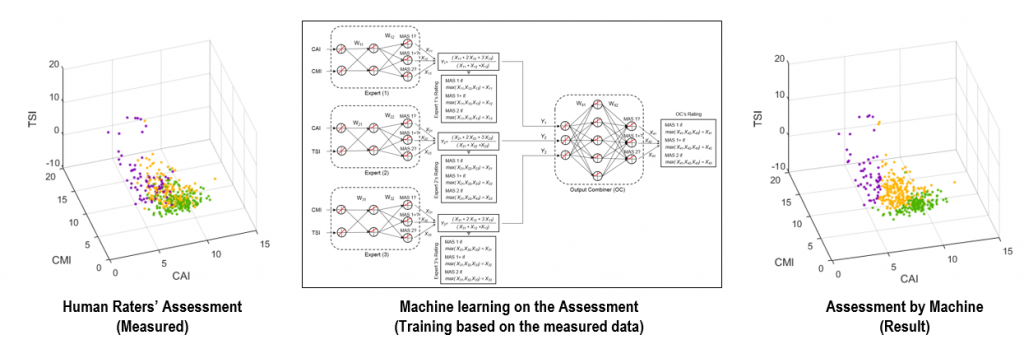Our Research
Assessment Robotics
Development of Haptic Training Tools for Objective Assessment.
In rehabilitation medicine, most assessments still depend on subjective perception of clinicians. The subjectivity degrades reliability of the assessment scales. For reliable assessment, we developed robotic devices which provide haptic simulation of patients for repeatable and objective training of assessment. We also developed haptic models of spasticity, one of the most prevalent impairments, and implemented the models to the simulator. Novice clinicians can be familiarized with the clinical assessment scales through practices using the simulator.

Quantitative Analysis and Automation of Clinical Assessments.
We are also interested in understanding the subjective clinical assessment scales. We obtained biomechanical data (motion, force, muscle activations and so on) of patients and assessment results rated by human clinicians. Then, we are trying to develop numerical models of how clinicians rate the patients by applying various machine learning techniques. Based on the understanding, we can automate the clinical assessments.

Robotics for Hand Manipulation
Soft Hand Exotendon Device providing dexterous motions
Hand is the most affected body part in the upper limb caused by neurological disorders, and the recovery is known to require most time. We are developing a soft hand exotendon device that replicates the structure and function of the hand tendons and muscles to provide dexterous motions with a compact and light design. Repetitive training of various grasping task will be available by using this device, which is expected to improve the recovery of hand functions for activities of daily living.

Biomimetic Skin Structure for Prosthetic Hand
Development of skin structure for prosthetic hands by mimicking the structure of human skin. By applying the porous silicone structure as the subcutaneous fat layer, developed skin structure has similar stiffness characteristics of human skin. thus it has similar functionality (stability) of human skin. Research is underway to reproduce skin wrinkles and deformations due to the hand motions.

Exoskeleton for Upper Limb
Shoulder disorders became more prevalent in recent years due to the increase in injuries in sports as well as neurological disorders. The patients suffering from the shoulder injuries don’t use the damaged side, so they deteriorate over time. Also, the shoulder joint is the most complex joint in the human body. If the movement of the shoulder joint is not considered, they feel uncomfortable force from the device. The shoulder rehabilitation robot is a low-end shoulder rehabilitation system using only one actuator and passive shoulder joint tracker. It provies various rehabilitation motion and treatment modes for the patients. The system also includes interesting games.

Home-Based Exercise Monitored by Artificial Intelligence for Rehabilitation
This project aims on detecting the rehabilitation exercise motion for shoulder patient during home rehabilitation exercise. Home exercise is essential for the success of rehabilitation treatment. To carry out the purpose, we used IMU sensor signal and various IT technology such as network programming, database and android(java) programming. By cooperating with rehabilitation hospital, patient’s exercise data are obtained and transmitted to the database. Based on the clinical data, deep learning algorithm detect and classify various shoulder exercise and save it as clinical information.

VR-based Gait Rehabilitation
Treadmill training is widely used for patients with gait disorder because it provides comfortable and safe environment. By providing a virtual reality for gait rehabilitation, the patients can walk curve as well as straight. In addition, patient can not only be actively participated in training by carrying out the task but also be motivated to training using game provided by VR. Furthermore, we are monitoring the brain activation during gait training using EEG to evaluate the effect of the system.



